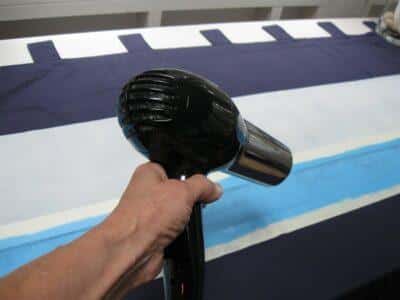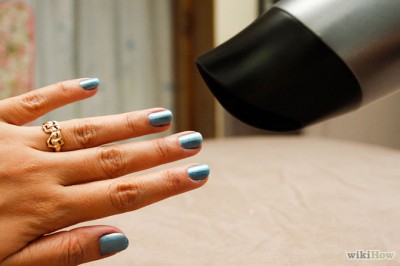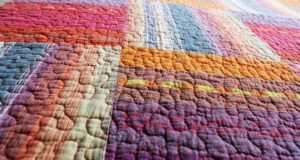
Image source: designmegillah
My large, active family tends to put some wear and tear on appliances. Now that the weather is warm, we tend to be in the freezer a lot for ice. Last week, though, the freezer door was left partially open for several hours because something was blocking it.
Ice had quickly built up on the back of the freezer, ice was frozen in the ice maker and the cooling system was not cycling on and off as it should. This type of situation once brought fear to my heart, but not any longer. Instead of calling the appliance repair service, I calmly cleared out the freezer and armed myself with my hair dryer.
By directing the hair dryer’s warm air directly onto the trouble spots and melting the ice build-up, my freezer was back in working order in no time.
A small electric hairdryer is much more than a beauty appliance. It can produce 2,000 watts of heat and can be very useful for a variety of jobs around the house and for those living a self-sufficiency life. Here are 11 ideas for alternative uses for your hair dryer.
1. Drying paint. Warm air from a hair dryer can hasten the drying process on doors, steps or other areas that may need to get dry fast. A hair dryer is also useful in drying art and craft projects so that they can be safely handled or moved.
2. Setting manicures. Speaking of paint, next time you give yourself a manicure or pedicure, try using a hair dryer to help the polish set without smudging.
3. Spot drying your clothing. When you spill on your clothes or get caught in the rain and don’t want to change, use a hair dryer to quickly dry the area.
4. De-frosting frozen locks. If you have ever had a key break in a frozen door lock, you know how frustrating it can be. Try warming the lock mechanism on your car or home door with a blast from your hairdryer on icy days.
5. Removing sticky residue. When you want to remove a sticker, price tag bumper sticker or label or just the glue that remains, try using a hair dryer to heat it so that the sticky stuff peels off easily.
 6. Melting candle wax. If a candle has dripped on your table or counter, skip the scratching and melt it with a hairdryer. Then wipe it away.
6. Melting candle wax. If a candle has dripped on your table or counter, skip the scratching and melt it with a hairdryer. Then wipe it away.
7. Icing a cake. You can give your party cakes a professional-looking glossy finish by slowly blowing a blast of low heat over the frosting.
8. Removing stuck chewing gum. A hairdryer can be handy in removing hardened chewing gum from carpet, clothing, furniture or even hair. Just target the heat long enough on the area to soften the gum and then remove.
9. De-frosting pipes. Plumbers even recommend this one. Use a hairdryer to safely thaw frozen pipes. Similarly, if you have a window that is frozen stuck, use a hair dryer to melt the ice.
10. Removing a bandage. Sometimes the pain of removing a bandage can be worse than the pain of the cut or scrape, especially for little ones. Try blowing some warm air on the bandage to melt the glue before easily pulling it off.
11. De-fogging mirrors and windows. Even with a bathroom exhaust fan, mirrors can get quickly fogged up after someone takes a hot shower. Use your hair dryer to clear things up in no time.
The first handheld hair dryer, which only produced 100 watts of heat and weighed in at over two pounds since it was made of steel and zinc, appeared on the market in 1925. Over the next two decades, engineers tripled the wattage and improved the design. Further improvements caused the heat output to be raised to 500 watts by the 1960s.
Safety from electrical shock and from fire has been a concern with hairdryers from the beginning. Beginning in the 1970s the Consumer Products Safety Commission (CPSC) recommended safety guidelines for hair dryer manufacturers. By then, smaller more efficient motors allowed for better airflow as well as higher heat output. By the 1990s, handheld hair dryers could produce more than 1,500 watts of heat and were smaller and lighter than ever thanks to new plastic designs and new insulating materials. Today, most stores sell a selection of affordable hair dryers that can produce up to 2,000 watts of heat.
Some newer hair dryers use ionic or infrared technology to shorten drying time and feature a “cold shot” button to set hair. Instead of heating air like a traditional blow dryer, an ionic one uses charged ionic particles to dissolve moisture droplets. According to a Good Housekeeping Institute report, the difference between drying time between ionic dryers and traditional ones is not significant.
Whatever you end up using it for, a quality hair dryer should have an automatic shut-off feature for when it reaches a certain temperature, three levels of heat settings and a removable filter that can be easily cleaned.
If you have other alternative uses that have worked for your hair dryer, let us know in the comments below.
Sign up for Off The Grid News’ weekly email and stay informed about the issues important to you
 Off The Grid News Better Ideas For Off The Grid Living
Off The Grid News Better Ideas For Off The Grid Living




